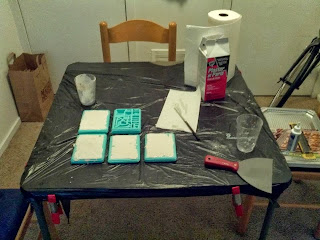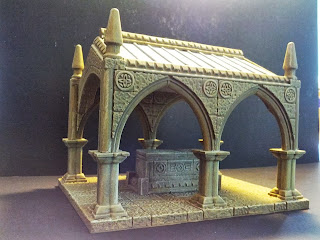I've decided that before I start getting into the detailed tutorials about casting and building and painting, I should put up something a bit more basic, for the new modeler. This will be the first in a series of core posts about all of the random stuff that every modeler should have in their inventory.
Part 1 will focus on the things you'll want to have before you pour your first cast. There are tons of resources out there for this, and I'll be citing a few, as well as adding my own thoughts about some stuff that's not covered elsewhere.
Lets start with the obvious: you are going to need a table. You may think "Thanks, jerk, I know I need a table" but the choice of table is incredibly important for a number of reasons.
The top surface needs to be hard. Even a finished wooden top is probably not going to be hard enough.
 |
| Pictured: Bad Table |
Eventually I found a used drafting table at a furniture consignment store for about $35. It has two-point adjustable height on all four legs, a nice hard MDF surface covered in a hard white paint, a tool cup attachment down one side, and a mount for an overhead light:
 |
| Now that's a work space |
Speaking of lights, a good light with a natural bulb on a mobile arm is absolutely essential. It's not as crucial to casting as it is to things like painting and assembly, but you will want good clear lighting over your entire work surface. I'll write more about lighting in a future post on painting.
You'll also need a few hand tools. Any list online will tell you that you absolutely need a putty knife, as the last step in casting is scraping the excess plaster from top of the molds to create a smooth surface. It's also great for scraping the hardened scrap plaster off of your sweet table. That red-handled one is still in use in my workshop.
A good steel file is another crucial part of the toolbox, though not one that you see on most online lists, as many people use sandpaper instead. The one I found to be the best, and the most frequently used tool in my kit, is flat on one side with rough and fine surfaces, and then convex on the other side, again with rough and fine surfaces. It's useful not only for smoothing out the 'scrape side' of the finished pieces but also for keeping the edge on your putty knife free of little plaster bits that can muck up your scrapes.
 |
| A steel file and a model of a fireplace |
Third is your container sets. Plastic solo cups for mixing plaster, a bucket for mixing wetwater if you choose to cast using wetwater, a construction bucket to store your plaster, some tiny plastic cups to scoop and sift the powdered plaster, and some disposable spoons for stirring and precision pouring.
The final tool that you'll need to purchase is a hobby knife, like an X-acto or similar product. While mostly used for smoothing out tiny details, a hobby knife is also the perfect tool for etching indicators into the finished pieces, making them much easier to sort. Make sure to get extra blades as well. They dull very quickly, especially when cutting plaster or foamcore board.
Finally, what I call the bucket of diddlies. I use a few old tobacco cans because of the wide opening and the fact that they're free with the purchase of roll-your-own tobacco (my preferred tobacco intake method), but mason jars or empty aluminum food cans work just fine. Sorted out between them are about 100 safety pins and paper clips of all different sizes, some kebab skewers, a handful of pipe cleaners, some 200 grit sandpaper, a pair of scissors, a wire cutter, miscellaneous binder clips, push pins, an old 3/0 paintbrush and a multi-tool pocketknife. You'll never know when you need a tiny wire bit or the saw tool on the pocketknife, so it's better to be prepared for anything than to ruin a whole day of casting because you're missing some important tool.
Next up - What to do with all of the new tools.











